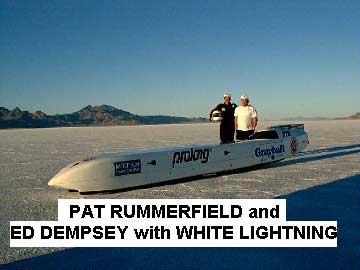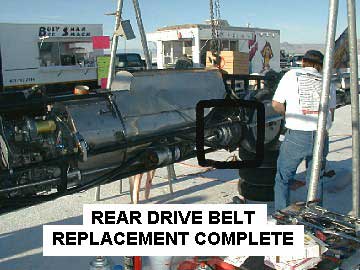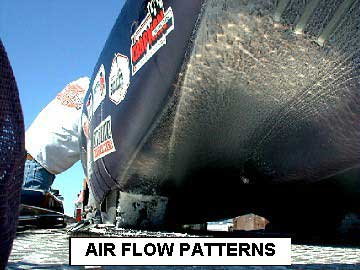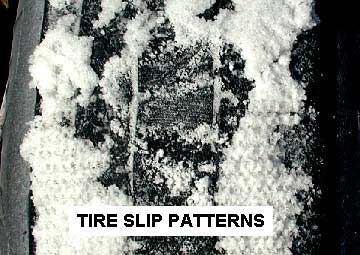INSIDE
RACING
T E C H N O L O G Y
IRT Home
IRT Home
News Page
Contents Page
Newsletter &
Books
email Paul
Bonneville
Page 1
Page 1
BONNEVILLE SALT FLATS: WORLD FINALS
Page 2
October 20-24, 1999

I came with Ed Dempsey of Dempsey's World Record Associates (DWRA) who owns the "White Lightning" electric powered car and co-sponsors the Vesco 4WD helicopter turbine powered "Turbinator." Power for the electric car now comes from 6,120 sub-C Nickel-Metal Hydride (NiMH) batteries. These batteries are used in portable power tools. MoltecH (Molecular Technology) just bought out the industrial power battery division of Energizer and are an associate sponsor of the car. White Lightning currently holds the US record at 239 MPH.
Turbinator is a 4WD helicopter turbine engine powered LSR car. Ed Dempsey obtained a new (different, surplus) turbine engine with about 3600 HP at sea level for the Turbinator and this meet. The first speed runs with the engine are about to occur. All that is known is that the car moves sooner with lower turbine revs (at Vesco's shop). The Turbinator holds the current US record at 417 MPH.
TURBINATOR DAILY DIARY
After setting up the pit and preparing Turbinator, the engine is run up and all wheels driven to beyond maximum expected speed. The car is hung on "A" frames for this operation. All body panels are put on the car and it is towed to the start line on it's trailer. Turbinator starts the first run. Sounds great as it goes by the pit at about 300 MPH in the first measured mile. But something keeps the car from accelerating further and max speed is 351 MPH. After looking at all kinds of info and data it is believed that a false signal limited the fuel valve opening.
On day 2 the cleaning of the car and run preparation are again completed. Off to the start line and another run. On this run the top speed was 351 MPH, the same darn thing. Now the team makes a call to the turbine people in Seattle and gets some advice. The car is prepared again and run in mid-afternoon. The result is another 351 MPH run. Now the turbine people get a frantic call from Vesco. The result is that a new fuel control valve is being flown down and a helicopter engine repair guy coming.
Most of the morning of day 3 is spent installing the new fuel control valve. All of the team guys are keeping their cool and just plugging away getting the work done. You'd never believe there was any pressure. Just after lunch the engine is fired and all running gear and systems checked. Off to the start line. This time as Turbinator goes by the pit the whine of the turbine keeps increasing and the car "whoosh" sounds fantastic. Top measured speed was over 425 MPH. Just after the second measured mile the rear wheel drive belt shredded. Don Vesco knew something happened and the car only had 2 wheel drive and maybe some slip. Well, no 2 way run today. The car goes to impound so a US record can be set on the next run. Then if all goes well a return for the FIA record can be made.

Changing the drive belt is no easy task. This car wasn't built with disassembly and changing belts in mind. The task takes the team through most of the fourth and last morning. But the plan is to run south for the US record (2 different days) then return for the FIA record within an hour. Everything looks good on the checkout. Engine OK, belts running fine and tension proper. Turbinator went 429 MPH on the run south. So a US record of 427.832 MPH was set. Now for the run north. OH NO! The word is that the car hit some bumps and grooves in the track and lost the transmission.
Well that's it for the TURBINATOR at the 1999 World Finals. A new US record but no FIA record. That extra engine power may be showing the next failure mode.
WHITE LIGHTNING DIARY
The team came with the intention of just getting the car inspected on day one. With the late arrival and pit prep the car didn't go to tech until mid afternoon. Got a variance to have only a partial number of battery packs in the car. The car is supposed to be in running condition and 20 packs (306 cells each) of batteries are required. But the team is conditioning most of the packs.
On day 2 the only run planned is a checkout run. The new Nickel-Metal Hydride (NiMH) batteries haven't been run down the track yet. The batteries are charged, checked, and the car ready to go. As the car goes by on the front pit lane all that is heard is the crunching of the salt and some wind noise. I think it is neat, the real sound of speed. White Lightning goes 238 MPH in the third mile for leg 1 of a US record. So the car had to stay in the impound area until the next run south was made.
The plan on day 3 is to run south to establish a US record, then turn around an make a return run within an hour for the FIA record. Both battery units are charged and ready to go. The car is ready to go. The driver is ready. The team has been planning who does what so the 20 battery packs can be changed, car checked, info downloaded, and driver kept cool. The car goes off to the start line. At this point I am informed that I have a task to perform on the turn around. Holy mackerel what is my chore, when do I leave, who do I go with? Now I'm off to the 5 mile marker with the safety team. The CB crackles ... "the Electric car is leaving." The first speed splits are announced, the car is going better than yesterday. As the car rips past the 5 mile marker the chute is released and a mile 3 speed of 248 MPH announced. Great, a new US record. The car sounded fantastic and you could hear the chute "pop". Quick into the car and off to the 8 mile marker at 90 MPH. It takes an eternity to get there. But White Lightning just turned off the course to get to the awaiting team truck and officials.
The driver stays in the car. Off comes the top body panel. Battery data on the pack just run is checked to be sure everything is OK. The drag chute is being repacked. The empty battery cart is wheeled up and the 20 packs unplugged, lifted out, and placed in the cart. Now the fresh batteries are loaded. In the meantime the portable generator is going and air being blown through the motors to cool them. The motors look like about 5 HP motors but they put out 200 HP each. The fresh batteries are in and connected. The top body panel is put on the car. Since no motor check was done the car will be driven to the return start line. Now the safety team has to get to the 3 mile marker, the shut off point of the run north. Off we go. If he leaves soon it seems as if White Lightning will go by before we get there even at 90 MPH. Finally the 3 mile marker. As we get there we see that race officials have decided to let several vehicles run south that only get to go to the 3 mile marker from the north, they don't go fast enough to be allowed to run the full course.
But then disaster. The third vehicle has a problem and is burning on course. White Lightning has to wait out the clean up and readiness of the medical emergency vehicle. Finally White Lightning is off with several minutes to spare. The last mile speed we heard was 247 MPH for an FIA world record just below 248 MPH. I don't know if this will be a US record or not. Our team races to the finish line, again just as the car pulls off course. All wasn't as rosy as we thought. Pat Rummerfield, the driver, tells us that he hit a rut and went on 2 wheels in the second measured mile and the car veered off course, he over corrected and the car was back on center, then went right again, where he finally got the car under control. At that point he was going right for the 3 mile marker. Pat said he wasn't about to turn so he went right through the center of the mile marker and popped the chute. Mile 2 is where the official measurements ended. We were at the 3 mile marker and didn't see a thing. The car was scraped up some and a small chunk of skirt missing on the left side. So as Pat got out of the car he said "I'm going to Disney World" (and Disneyland too) for the TV film crews. A 2 hour show will be on eXtreme Sports on SpeedVision in February.
The official FIA electric powered vehicle record by White Lightning is 245.524 MPH. FIA used the slower last mile speed (mile 3 to mile 2) of the car (243 MPH) when it hit the mile marker. So FIA used the last mile speed each way for the record, not the fastest speeds. But hey, it's still a new FIA record.
On day 4 the plan was to explore the limits of the NiMH batteries. All runs to this point had been on cold batteries, as night time temperatures were about 35-40 degrees F. So 2 electric heaters were put in the trailer to keep the temperature up a little. The heaters were near a blower that circulated air over all batteries. The car had to stay in impound. During the night one heater tripped a circuit breaker. The batteries are just cool. So battery warming continues as the car is checked in impound (impounded for the FIA record and today's US record attempt). The warm batteries are finally loaded in the car and plugged in. But White Lightning isn't allowed to go to the north start line because a car is waiting to run north for a FIA record. But before that happens Vesco is to run south in the Turbinator on the first leg of an FIA attempt. So we have to wait for 2 cars to come north. Vesco runs south. The other car, Al Teague #76, runs north at 387 MPH to set a new AA/BFS record. Then the announcement that Turbinator broke the transmission. Several vehicles and White Lightning are released to go to the north start line. On the last run of the day, and meet, White Lightning went 254 MPH. The car went to SCTA impound for a few minutes to be checked and the official US record is now 251.322 MPH.
COMMENTS

The salt patterns deposited on cars really shows how the air flows around the vehicles. The photo above shows air flow behind the rear tires of a streamliner. The change in pattern part way back is probably where air flow is separating from the body. Interesting.

I couldn't believe that such fine slip patterns on the tires would be produced by salt surface. This photo shows the pattern that goes across the tread indicating longitudinal acceleration. The grooves are only about 0.020 to 0.030 inches apart. The uniformity of the grooves is surprising. I didn't get a chance to see the actual racing surface to observe smoothness. I will be re-thinking what goes on in the tire contact patch.
SUMMARY
My first visit to Bonneville was fantastic. The assortment of cars was great and I have no idea how many classes they fit into. The people in the LSR community are very cordial. They are willing to take time to answer questions and show you their machines. Hope I'll get back sometime soon.
Here are some web pages to visit:
http://www.dwra.net/ White
Lightning site.
http://www.teamvesco.com/
Team Vesco site.
http://www.saltflats.com/
Utah Salt Flats Racing Association site.
http://roadsters.com/bonneville/
Bonneville Speed Weeks site.
http://www.simonlewis.com/lsr.html
Simon Lewis Bookshop site.